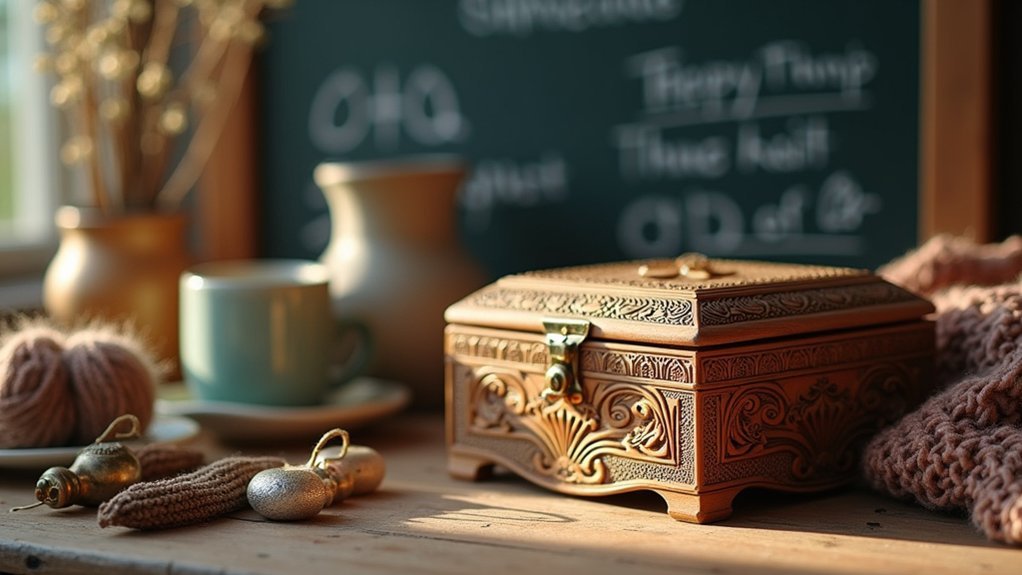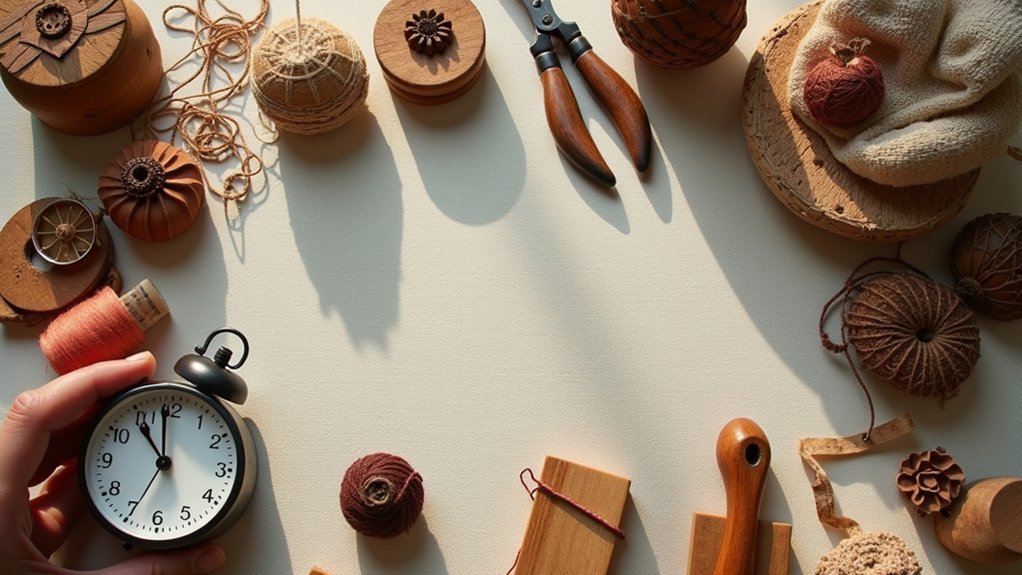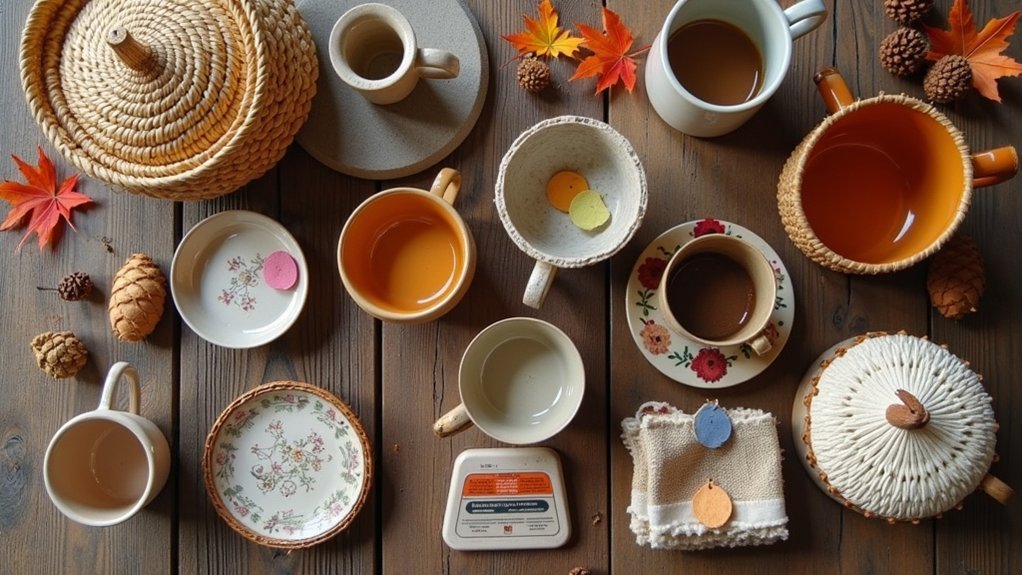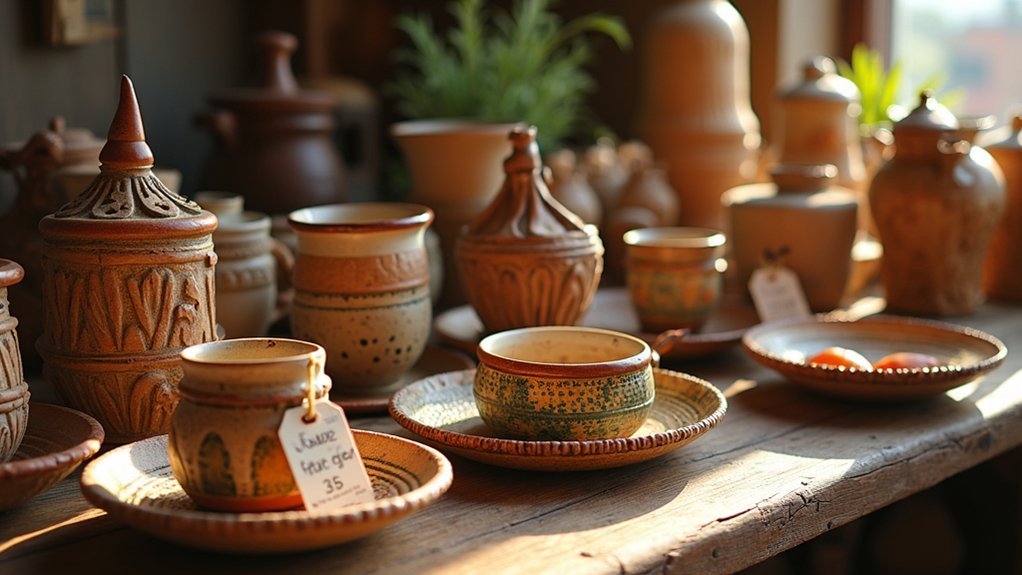You’ll maximize profits with strategic markup approaches: calculate true production costs including materials, labor, and overhead, then apply 50-100% markups for retail sales. Use value-based pricing to capture premium profits by emphasizing your unique craftsmanship story. Research competitors to position yourself strategically while valuing your skilled labor time appropriately. Implement seasonal pricing during peak demand periods and monitor profit margins weekly to maintain 20-30% targets. These proven strategies transform intuitive pricing into sustainable business growth.
Cost-Plus Markup Strategy for Handmade Jewelry

The cost-plus markup strategy provides a straightforward foundation for pricing your handmade jewelry by calculating all production expenses and adding a predetermined profit margin.
Cost-plus markup strategy offers a simple, reliable method for pricing handmade jewelry through calculated expenses plus predetermined profit margins.
You’ll need to track the total cost of materials labor overhead, including gemstones, metals, and tools used in each piece. Typically, you’ll add 50% to 100% markup percentage to establish your retail price.
For instance, if your handmade jewelry costs $30 to produce, a 100% markup sets your retail price at $60.
You must regularly reassess both expenses and markup percentage since material costs fluctuate.
This pricing strategy guarantees transparent cost coverage while maintaining consistent profitability, creating sustainable business growth for your jewelry-making venture.
Value-Based Pricing for Unique Artisan Pieces
While cost-plus markup provides a solid foundation, value-based pricing allows you to capture especially higher profits by setting prices according to what customers perceive your unique artisan pieces are worth.
This strategy requires thorough market research to understand customer willingness to pay and competitive positioning. You’ll need to effectively communicate your craftsmanship’s distinctive qualities to enhance perceived value.
Boost your pieces’ worth by highlighting your creation story, exclusive materials, and time invested. This justifies premium prices and can generate profit margins of 20-50% or more.
Success depends on regularly gathering customer feedback and monitoring market trends to adjust pricing appropriately.
Value-based pricing transforms your handmade items from mere products into coveted artisan pieces that command higher prices.
Competitive Market Analysis and Positioning

Since understanding your competition directly impacts your pricing success, you’ll need to systematically analyze similar handmade products in your niche to uncover pricing patterns and market gaps.
Start by conducting a competitive market analysis using online platforms to gather pricing data on comparable items. Examine their pricing structures while considering factors like unique craftsmanship, material quality, brand reputation, and perceived value.
Position your handmade products by developing a strong unique selling proposition that emphasizes your artisanal story and consumer connection. This differentiation justifies premium pricing when you effectively communicate your value.
Monitor market trends regularly and adjust your pricing strategy based on competitor shifts and customer feedback.
Material Cost Recovery and Overhead Allocation
Accurate pricing hinges on meticulously tracking every material expense that goes into your handmade creations. Calculate your total material costs for each piece, then determine your overhead allocation by dividing monthly overhead expenses by production volume. This gives you actual production costs beyond raw materials.
| Cost Component | Monthly Total | Per-Item Cost |
|---|---|---|
| Materials | $300 | $15 |
| Overhead Expenses | $200 | $10 |
| Combined Base Cost | $500 | $25 |
Apply markup to both material costs and overhead allocation when pricing handmade goods. Your retail prices should cover production costs plus generate acceptable profit margin for your craft business. Review these calculations monthly, adjusting overhead allocation as production volumes change to maintain profitability and competitive positioning.
Labor Time Valuation and Skill-Based Pricing

Beyond material costs and overhead, you must account for the most significant component of handmade pricing: your labor investment.
Calculate your hourly wage by determining what your specialized skills deserve, then multiply by actual production time per item. Skill-based pricing allows you to charge premiums for techniques that mass production can’t replicate.
Consider these emotional realities of undervaluing time:
- You’re working for less than minimum wage while creating luxury items
- Your expertise becomes worthless when you don’t factor it into markup
- Burnout becomes inevitable when profit margins don’t sustain your livelihood
Regularly reassess your labor costs as efficiency improves.
Your pricing strategies for handmade pieces should reflect true production costs per item, ensuring costs associated with making don’t erode your handmade pricing structure.
Premium Pricing for Luxury Handcrafted Items
When you position your handcrafted items in the luxury market, you’re not just selling products—you’re selling exclusivity, artistry, and an experience that mass-produced goods can’t deliver.
Premium pricing becomes your strategic advantage, allowing markups of 100% or more by emphasizing unique design, superior craftsmanship, and quality materials that justify higher costs.
Consumers naturally associate elevated prices with superior quality, enhancing perceived value for your luxury goods.
You’ll strengthen this position through effective branding and storytelling that creates an emotional connection with customers, making them willing to invest more in your artisanal process.
Success requires thorough market research to identify target demographics who value handcrafted excellence over mass production, ensuring your premium strategy aligns with customers ready to pay for authentic luxury.
Wholesale vs. Retail Markup Calculations

Understanding the distinction between wholesale and retail markup calculations will dramatically impact your handmade business’s profitability and growth potential.
Mastering wholesale versus retail pricing strategies is the cornerstone of sustainable handmade business success and long-term profitability.
When pricing your products for wholesale, you’ll typically set prices at 50% of retail to allow retailers their desired profit margin. Start by calculating your production costs, then multiply by two for wholesale pricing.
For retail markup calculations, consider these emotional factors:
- Your creative time deserves premium compensation – don’t undervalue your artistry
- Quality materials justify higher selling prices – customers recognize craftsmanship
- Unique pieces command respect – embrace your worth at craft shows
Platform Fee Integration in Pricing Models
Since online marketplaces have become essential sales channels for handmade businesses, you’ll need to build platform fees directly into your pricing structure rather than treating them as afterthoughts that eat into your profits.
Start by calculating all associated costs: Etsy fees typically include 5-6.5% transaction fees, $0.20 listing fees per item, and 3-4% payment processing fees. Add these percentages to your base price before setting your retail price.
For example, if platform fees total 10%, increase your pricing model accordingly to maintain healthy profit margins.
Don’t simply absorb these costs—that’s a recipe for shrinking profits. Instead, regularly adjust prices when platforms modify their fee structures.
This proactive approach guarantees your handmade business remains profitable while staying competitive in the marketplace.
Seasonal and Dynamic Pricing Adjustments

Because market demand fluctuates throughout the year, you’ll maximize profits by implementing seasonal pricing adjustments and dynamic pricing that respond to these predictable patterns.
By monitoring sales data and consumer behaviors, you can strategically time promotional sales when 60% of consumers are most likely to purchase.
Your pricing strategies should include:
- Holiday premium pricing – Capture peak demand with strategic price increases during high-traffic seasons
- Off-season discount campaigns – Clear inventory levels while maintaining cash flow during slower periods
- Limited edition urgency – Drive immediate action during product launches with exclusive pricing
Dynamic pricing lets you adjust real-time based on competitor actions and inventory levels.
Regularly collect customer feedback to refine your approach, ensuring your seasonal adjustments align with actual market performance rather than assumptions.
Profit Margin Optimization for Sustainable Growth
You’ll achieve sustainable growth by first calculating your true production costs, including both materials and labor expenses that many artisans overlook.
Next, you should establish strategic markup percentages that typically range from 100% for wholesale opportunities while maintaining profit margins between 8% to 30%.
Finally, you must consistently monitor your performance metrics to identify which products generate the highest returns and adjust your pricing strategy accordingly.
Calculate True Production Costs
When pricing handmade pieces for long-term success, understanding your true production costs forms the foundation of profitable business operations. You must calculate true production costs by summing materials, labor, and overhead costs per item—which can range from $26 for basic pieces to higher amounts for complex creations.
To avoid devastating pricing mistakes that crush your dreams:
- Track every expense meticulously, from thread to workspace rent.
- Assess production efficiency regularly to prevent undervaluing your artistry.
- Determine your desired profit margin (typically 8-30% for handmade products).
Use this formula for your selling price: total production costs ÷ (1 – desired profit margin).
Then incorporate a markup strategy with 100% retail markup over wholesale prices, ensuring your business goals remain achievable while protecting against unforeseen expenses.
Set Strategic Markup Percentages
Three distinct markup approaches will transform your handmade business from struggling to sustainable.
First, apply a 100% markup for wholesale pricing to distributors, giving them room for profit while protecting your margins. For direct retail sales, use 50-70% markup based on your production costs and overhead expenses.
Second, target a 20-30% profit margin after calculating all expenses, including labor and materials. This guarantees long-term sustainability while remaining competitive.
Third, conduct thorough market research to understand customer willingness to pay and competitor pricing strategies.
Your strategic markup should justify higher prices through perceived value while maintaining market position.
Regularly reassess these percentages when production costs change or demand shifts, guaranteeing your handmade pricing strategy supports profitable growth and business sustainability.
Monitor Performance Metrics
Setting strategic markup percentages provides the foundation, but tracking performance metrics determines whether your pricing strategy actually delivers sustainable profits.
You’ll need to monitor key sales performance metrics including average order value and customer acquisition costs to identify profitable trends.
Utilize pricing calculators and spreadsheets to track how production costs impact your profit margin calculations.
Transform your handmade business by implementing these critical monitoring strategies:
- Analyze profit margins weekly – Maintain 8-30% margins for sustainable growth while covering all costs
- Track customer acquisition costs – Verify marketing investments generate profitable returns
- Adjust pricing based on market conditions – Respond to consumer willingness to pay and demand fluctuations
Review your pricing strategies quarterly, adapting to changing market conditions while maintaining alignment between production costs and customer value perception for maximum profitability.
Frequently Asked Questions
What Is a Good Profit Margin for Handmade Items?
You’ll want to aim for a 20-30% profit margin on handmade items. This guarantees sustainability while covering all costs including materials, labor, and overhead. You can adjust based on market demand and production volume.
How Should I Price My Handmade Items?
Calculate your total costs including materials, labor, and overhead. Apply a 100% markup for wholesale pricing, then double that for retail. Factor in marketplace fees and maintain a 5-30% profit margin.
What Is the Best Selling Platform for Handmade Items?
You’ll find Etsy’s the top choice for handmade items, offering 4.5 million sellers and buyers seeking unique crafts. If you want branding control, choose Shopify. For massive reach, try Amazon Handmade despite referral fees.
How Much Should I Charge for Something I Made?
Calculate your material costs, labor time, and overhead expenses first. Then multiply your total costs by two for retail pricing. This guarantees you’ll cover expenses while earning profit on your handmade creation.
In Summary
You’ll maximize your handmade business’s profitability by implementing these strategic markup approaches. Don’t rely on just one method—combine cost-plus calculations with value-based pricing to reflect your artisan skills. You’re building a sustainable business, so factor in all your costs while positioning competitively. Remember, you can’t afford to undervalue your craftsmanship. Test different strategies, monitor your margins, and adjust seasonally. Your pricing should support both immediate sales and long-term growth goals.





Leave a Reply